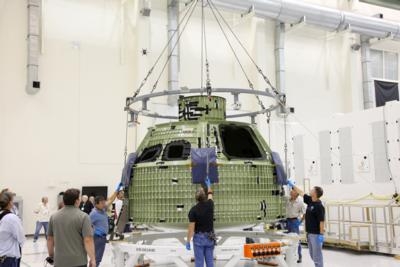Tue, Jul 03, 2012
Agency Takes The Wraps Off First Capsule Destined For Space
The first space-bound Orion capsule has arrived at NASA's Kennedy Space Center in Florida where technicians will turn it into a fully functioning spacecraft ahead of a test flight slated for 2014. The uncrewed flight, called Exploration Flight Test-1 or EFT-1, will be loaded with a wide variety of instruments to evaluate how the spacecraft behaves during launch, in space, and through reentry.

Lori Garver, NASA's deputy administrator, joined a group of officials on Monday to welcome the Orion spacecraft, marking its arrival at Kennedy -- a major milestone in the construction of the vehicle. The space-bound Orion was welded at NASA's Michoud Assembly Facility in New Orleans, in the same factory that built the external tanks for space shuttle missions.
Assembly at Kennedy will take place in the high bay of the Operations and Checkout Building, or O&C. The O&C was refurbished extensively in 2006 and has been outfitted with large fixtures and tools to turn the aluminum shell of Orion into a functioning spacecraft complete with avionics, instrumentation and heat shield.
In 2014, a Delta IV-Heavy rocket from United Launch Alliance will lift the spacecraft into orbit. Its second stage will remain attached to the capsule and will be fired to raise the Orion's orbit to 3,600 miles, about 15 times higher than the International Space Station. The mission will last only a few hours, long enough to make two orbits before being sent plunging back into the atmosphere to test it as deep-space reentry speeds.
Designed with astronauts in mind, Orion will take crews beyond Earth orbit for the first time since 1972, when Apollo 17 completed the last moon landing. The Space Launch System, or SLS -- a gigantic rocket akin to the Saturn V that launched the Apollo spacecraft -- is being developed to launch future Orion missions to deep space. The first launch of the SLS, with Orion atop, is scheduled for 2017.
NASA plans for later Orion spacecraft to take astronauts on missions to destinations far beyond Earth, like an asteroid and Mars.
More News
An Amazing Experience Awaits The Chosen Few... Oshkosh, to us, seems the perfect place to get started on watching aviation recover the past couple of years... and so ANN is putting>[...]
“NBAA has a tremendous responsibility to the business aviation industry, and we are constantly collaborating with them. Our flight departments, professionals and aircraft own>[...]
Dead Reckoning Dead reckoning, as applied to flying, is the navigation of an airplane solely by means of computations based on airspeed, course, heading, wind direction, and speed,>[...]
Aero Linx: Vertical Aviation Safety Team (VAST) We are a public–private initiative to enhance worldwide flight operations safety in all segments of the vertical flight indust>[...]
We're Everywhere... Thanks To You! Even with the vast resources and incredibly far-reaching scope of the Aero-News Network, every now and then a story that should be reported on sl>[...]
 ANNouncement: Now Accepting Applications For Oshkosh 2024 Stringers!!!
ANNouncement: Now Accepting Applications For Oshkosh 2024 Stringers!!! Aero-News: Quote of the Day (06.13.24)
Aero-News: Quote of the Day (06.13.24) ANN's Daily Aero-Term (06.13.24): Dead Reckoning
ANN's Daily Aero-Term (06.13.24): Dead Reckoning ANN's Daily Aero-Linx (06.13.24)
ANN's Daily Aero-Linx (06.13.24) ANN FAQ: How Do I Become A News Spy?
ANN FAQ: How Do I Become A News Spy?



